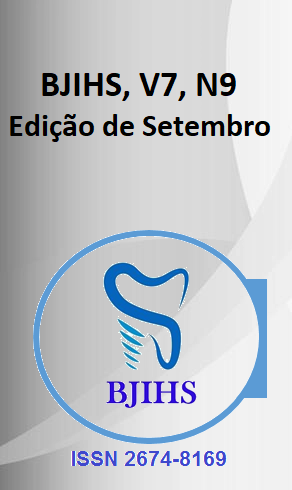Abstract
This study aims to analyze the epidemiological profile of leptospirosis in the state of RS between January 2020 and June 2024, highlighting the year 2024, when the largest water disaster in the region occurred. The research is cross-sectional and observational with a quantitative approach. The data extracted came from the Department of Information Technology of the Unified Health System (DATASUS), with information registered in the Information System for Notifiable Diseases (SINAN), in which the total number of infected people, the total number of deaths due to reported worsening, the difference in the number of infected people by sex and the difference in the number of infected people by age group, ethnicity and mesoregions were worked on. Based on the research, the vulnerability of the RS population to contamination by leptospirosis is observed, especially during periods of flooding. This recurring problem in the region contributes to the increase in the contagion rate, which explains the record number of cases recorded in 2024.In addition, the study revealed that the predominance of the zoonosis is concentrated especially in economically active white men from Porto Alegre, aged between 20 and 59, with complete or incomplete high school education, revealing a greater predisposition of this group to contract this disease. It is of fundamental importance to develop measures that seek to combat and reduce the damage caused by floods, which will reduce the potential for contamination of the disease in the region. Through actions such as improving infrastructure, climate recognition, advance planning and education of the population about the disease, the epidemiological situation of the zoonosis will be alleviated.
References
Da Costa Tonus L, Deziró Aranão G, Cacciari Vidal AC, Pires Soares Hirata J, da Fonseca Madruga MT. Análise epidemiológica da Leptospirose no Rio Grande do Sul, Brasil, de 2017 a 2022. Brazilian Journal of Implantology and Health Sciences. 25 de julho de 2024;6(7):2564–79.
Leão Silva Neris R, Ferreira de Almeida Silva K de C, da Silva MC, da Silva Batista M, Santos Avelar KE, Teruszkin Balassiano I. Emergência em saúde pública no Rio Grande do Sul: evento climático extremo e o impacto da leptospirose. Journal Health NPEPS. 1o de junho de 2024;9(1):e12664.
Magalhães VS, Acosta LMW. Human leptospirosis in Porto Alegre, Rio Grande do Sul, Brazil, 2007-2013: Characterization of confirmed cases and spatial distribution. Epidemiologia e Servicos de Saude. 2019;28(2).
Bueno CS, Ribeiro MT. PERFIL EPIDEMIOLÓGICO DOS PACIENTES AFETADOS POR LEPTOSPIROSE NA REGIÃO SUL DO BRASIL DE JANEIRO DE 2020 A JUNHO DE 2024. AR Internacional Health Beacon Journal [Internet]. 4 de novembro de 2024; Disponível em: https://orcid.org/0000-0003-2622-4996
Simas DC de S, Lima JS de, Sales RAC de, Norte NNB de O, Norte Filho AF do, Silva Filho EC e, et al. Desastres naturais e seus impactos nas cidades: estudo de caso da enchente histórica ocorrida no ano de 2024 no Rio Grande do Sul - Brasil. CONTRIBUCIONES A LAS CIENCIAS SOCIALES [Internet]. 13 de setembro de 2024;17(9):e10505. Disponível em: https://ojs.revistacontribuciones.com/ojs/index.php/clcs/article/view/10505
Ranieri TM, Viegas da Silva E, Vallandro MJ, Oliveira MM de, Barcellos RB, Lenhardt RV, et al. Leptospirosis Cases During the 2024 Catastrophic Flood in Rio Grande Do Sul, Brazil. Pathogens. 1o de abril de 2025;14(4).
Galan DI, Schneider MC, Roess AA. Leptospirosis Risk among Occupational Groups in Brazil, 2010-2015. American Journal of Tropical Medicine and Hygiene. 1o de agosto de 2023;109(2):376–86.
Carvalho Zanette AC, Korkmaz Guisard K, Rabelo de Souza Lima ME, Yurie Minasse C, Tiosso Rodrigues S, Martins Simões Candeia R. Panorama da Leptospirose no Brasil: Análise Epidemiológica e Fatores Socioeconômicos Influentes (2012-2022). Brazilian Journal of Implantology and Health Sciences. 31 de agosto de 2024;6(8):5757–66.
Martins MH da M, Spink MJP. Human leptospirosis as a doubly neglected disease in Brazil. Ciencia e Saude Coletiva. 1o de março de 2020;25(3):919–28.
Marteli AN, Genro LV, Diament D, Guasselli LA. Análise espacial da leptospirose no Brasil. Saúde em Debate. setembro de 2020;44(126):805–17.
Teles AJ, Bohm BC, Silva SCM, Bruhn NCP, Bruhn FRP. Spatial and temporal dynamics of leptospirosis in South Brazil: A forecasting and nonlinear regression analysis. PLoS Negl Trop Dis. 1o de abril de 2023;17(4).

This work is licensed under a Creative Commons Attribution 4.0 International License.
Copyright (c) 2025 TAYNÁ AYARA DUTRA, GABRIELA DE CARVALHO BAPTISTA DA FONSECA, JOÃO MATHEUS DOS SANTOS SILVA
